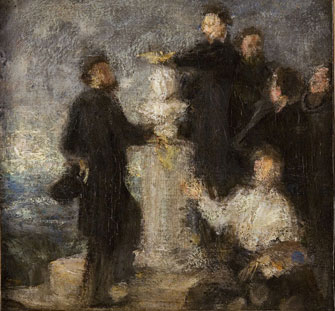A Model of Freedom and Catalyzer of Energies

A study (1863-64) for Henri Fantin-Latour’s “Hommage à Delacroix” (pictured below). © RMN (Musée du Louvre)/Harry Bréjat
This charming little exhibition at the Musée National Eugène-Delacroix pays homage to the great Romantic painter through tributes to him by other artists. The focus of the show is on the renowned painting “Hommage à Delacroix” (1864) by Henri Fantin-Latour (1836-1904), from which the rest of the exhibition radiates, illuminating the events and personalities of a crucial moment in the history of Western art, when a group of rebellious young artists took inspiration from one of their heroes to stand up to the academic establishment and successfully assert their own style.
As the Louvre’s director, Henri Lorette, writes in the exhibition catalog, Delacroix was “a catalyzer of new, unfocused energies,” who offered the younger generation “a model of freedom more precious than painting instruction.”
The monumental “Hommage à Delacroix,” which now belongs to the Musée d’Orsay in Paris, shows a group of artists and critics standing or sitting in front of a portrait of Delacroix, who had died a year earlier. Fantin-Latour was inspired to paint it by his disgust at what he considered the lackluster official tribute to the great departed artist at his funeral in 1863.
The young man went home and started working on his own accolade in oil. The many studies in the exhibition, carefully collected and preserved by his wife, the painter Victoria Dubourg, show the prodigious number of ideas he tested and rejected before finally settling on the arrangement that is so familiar to art lovers today. We see that he changed his mind many times about who deserved to appear in the painting, and that he originally planned to represent Delacroix more traditionally in the form of a bust surrounded by admiring artists and critics, in some versions with a female allegorical figure posed worshipfully below it, as in the sketch pictured above. In the end, Delacroix appears in the form of a portrait hanging on the wall in the center of the painting.
While most of the figures in Fantin-Latour’s picture have been forgotten today, four still live on in the collective memory: Fantin-Latour himself, oh-so-Romantic-looking with his swept-back hair and billowing white shirt, holding his artist’s palette; the painters Edouard
Manet and James McNeil Whistler; and the poet Charles Baudelaire. Some of the others are worth rediscovering: Albert de Balleroy, an aristocratic painter who is represented in the exhibition by a few works (including a lovely beach scene with big sky, leaping dogs and a woman walking into the wind) that show off his talent and his admiration for Delacroix, and Fantin-Latour’s friends Alphonse Legros and Félix Bracquemond, both of whom excelled in the art of etching. The others featured in “Hommage” are the critics Edmond Duranty and Jules Champfleury, and the painter Louis Cordier.
Just one year before Delacroix’s death, Manet and Whistler, whose work was mocked by critics, had shown their work at the Salon des Refusés after their paintings had been rejected by the official Salon, an annual exhibition that was indispensable to making artists known to the press and public. Manet’s now-famous painting “Déjeuner sur l’Herbe,” with its naked woman picnicking in the woods with fully clothed men, caused a scandal at the Salon des Refusés (which was actually sponsored by the government of Napoleon III to give the public a chance to judge the works rejected by the Salon).
While the introverted Fantin-Latour was associated with the Impressionists for a short time, he was never really one of their number. He became famous for and earned his living from his flower paintings, a niche he was constantly trying to break out of, and tended to go his own way, continuing to paint in a more traditional style.
His “Hommage à Delacroix” has often been used to justify the claim that Delacroix was the father of Impressionism, an idea the curators of this show dispute, noting that the “old lion” expressed little respect for the work of the young upstarts who admired his paintings.
The exhibition (don’t be misled by its title; it has little to do with Manet and Baudelaire, and a lot to do with Fantin-Latour) also offers a good excuse to visit the house and studio of Delacroix, with its lovely garden. It ends with another, simpler allegorical homage to Delacroix by Fantin-Latour, painted in 1889, and with studies for a group of bronze sculptures by Aimé-Jules Dalou. The official monument Delacroix did not want, the latter was erected in the Luxembourg Garden in 1890.
Musée National Eugène-Delacroix: 6, rue de Fürstenberg, 75006 Paris. Métro: Saint Germain des Prés. Tel.: 01 44 41 86 50. Open Wednesday-Monday, 9:30am-5pm. Admission: €7. Through March 19. www.musee-delacroix.fr
Please support Paris Update by ordering books from Paris Update’s Amazon store at no extra cost. Click on your preferred Amazon location: U.K., France, U.S.
Reader Reaction: contact@paris-update.com“>Click here to respond to this article (your response may be published on this page and is subject to editing).
More reviews of Paris art shows.
© 2011 Paris Update
Favorite
